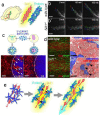Prospects and limitations of using endogenous neural stem cells for brain regeneration
- PMID: 24710140
- PMCID: PMC3924842
- DOI: 10.3390/genes2010107
Prospects and limitations of using endogenous neural stem cells for brain regeneration
Abstract
Neural stem cells (NSCs) are capable of producing a variety of neural cell types, and are indispensable for the development of the mammalian brain. NSCs can be induced in vitro from pluripotent stem cells, including embryonic stem cells and induced-pluripotent stem cells. Although the transplantation of these exogenous NSCs is a potential strategy for improving presently untreatable neurological conditions, there are several obstacles to its implementation, including tumorigenic, immunological, and ethical problems. Recent studies have revealed that NSCs also reside in the adult brain. The endogenous NSCs are activated in response to disease or trauma, and produce new neurons and glia, suggesting they have the potential to regenerate damaged brain tissue while avoiding the above-mentioned problems. Here we present an overview of the possibility and limitations of using endogenous NSCs in regenerative medicine.
Figures






Similar articles
-
Neural stem cells and strategies for the regeneration of the central nervous system.Proc Jpn Acad Ser B Phys Biol Sci. 2010;86(4):438-50. doi: 10.2183/pjab.86.438. Proc Jpn Acad Ser B Phys Biol Sci. 2010. PMID: 20431266 Free PMC article. Review.
-
Using endogenous neural stem cells to enhance recovery from ischemic brain injury.Curr Neurovasc Res. 2004 Dec;1(5):421-7. doi: 10.2174/1567202043361938. Curr Neurovasc Res. 2004. PMID: 16181090 Review.
-
Metformin Preconditioning of Human Induced Pluripotent Stem Cell-Derived Neural Stem Cells Promotes Their Engraftment and Improves Post-Stroke Regeneration and Recovery.Stem Cells Dev. 2018 Aug 15;27(16):1085-1096. doi: 10.1089/scd.2018.0055. Epub 2018 Jul 18. Stem Cells Dev. 2018. PMID: 29893190
-
Neural stem cells may be uniquely suited for combined gene therapy and cell replacement: Evidence from engraftment of Neurotrophin-3-expressing stem cells in hypoxic-ischemic brain injury.Exp Neurol. 2006 May;199(1):179-90. doi: 10.1016/j.expneurol.2006.03.016. Epub 2006 May 22. Exp Neurol. 2006. PMID: 16714016
-
Transplantation of Induced Pluripotent Stem Cell-Derived Neural Stem Cells Mediate Functional Recovery Following Thoracic Spinal Cord Injury Through Remyelination of Axons.Stem Cells Transl Med. 2015 Jul;4(7):743-54. doi: 10.5966/sctm.2014-0236. Epub 2015 May 15. Stem Cells Transl Med. 2015. PMID: 25979861 Free PMC article.
Cited by
-
Engineering of an electrically charged hydrogel implanted into a traumatic brain injury model for stepwise neuronal tissue reconstruction.Sci Rep. 2023 Feb 14;13(1):2233. doi: 10.1038/s41598-023-28870-z. Sci Rep. 2023. PMID: 36788295 Free PMC article.
-
Spatio-Temporal Patterns of Demyelination and Remyelination in the Cuprizone Mouse Model.PLoS One. 2016 Apr 7;11(4):e0152480. doi: 10.1371/journal.pone.0152480. eCollection 2016. PLoS One. 2016. PMID: 27054832 Free PMC article.
-
Enhancing endogenous capacity to repair a stroke-damaged brain: An evolving field for stroke research.Prog Neurobiol. 2018 Apr-May;163-164:5-26. doi: 10.1016/j.pneurobio.2018.01.004. Epub 2018 Feb 21. Prog Neurobiol. 2018. PMID: 29476785 Free PMC article. Review.
-
Stem Cell Therapy in Limb Ischemia: State-of-Art, Perspective, and Possible Impacts of Endometrial-Derived Stem Cells.Front Cell Dev Biol. 2022 May 23;10:834754. doi: 10.3389/fcell.2022.834754. eCollection 2022. Front Cell Dev Biol. 2022. PMID: 35676930 Free PMC article. Review.
-
Safety and Efficacy of Stem Cell Therapy in Ischemic Stroke: A Comprehensive Systematic Review and Meta-Analysis.J Clin Med. 2025 Mar 20;14(6):2118. doi: 10.3390/jcm14062118. J Clin Med. 2025. PMID: 40142929 Free PMC article. Review.
References
-
- Gerrard L., Rodgers L., Cui W. Differentiation of human embryonic stem cells to neural lineages in adherent culture by blocking bone morphogenetic protein signaling. Stem Cells. 2005;23:1234–1241. - PubMed
-
- Okada Y., Matsumoto A., Shimazaki T., Enoki R., Koizumi A., Ishii S., Itoyama Y., Sobue G., Okano H. Spatiotemporal recapitulation of central nervous system development by murine embryonic stem cell-derived neural stem/progenitor cells. Stem Cells. 2008;26:3086–3098. - PubMed
-
- Takahashi K., Yamanaka S. Induction of pluripotent stem cells from mouse embryonic and adult fibroblast cultures by defined factors. Cell. 2006;126(4):663–676. - PubMed
-
- Yamanaka S. Strategies and new developments in the generation of patient-specific pluripotent stem cells. Cell Stem Cell. 2007;1(1):39–49. - PubMed
-
- Zhang S.C., Wernig M., Duncan I.D., Brustle O., Thomson J.A. In vitro differentiation of transplantable neural precursors from human embryonic stem cells. Nat. Biotechnol. 2001;19(12):1129–1133. - PubMed
LinkOut - more resources
Full Text Sources

